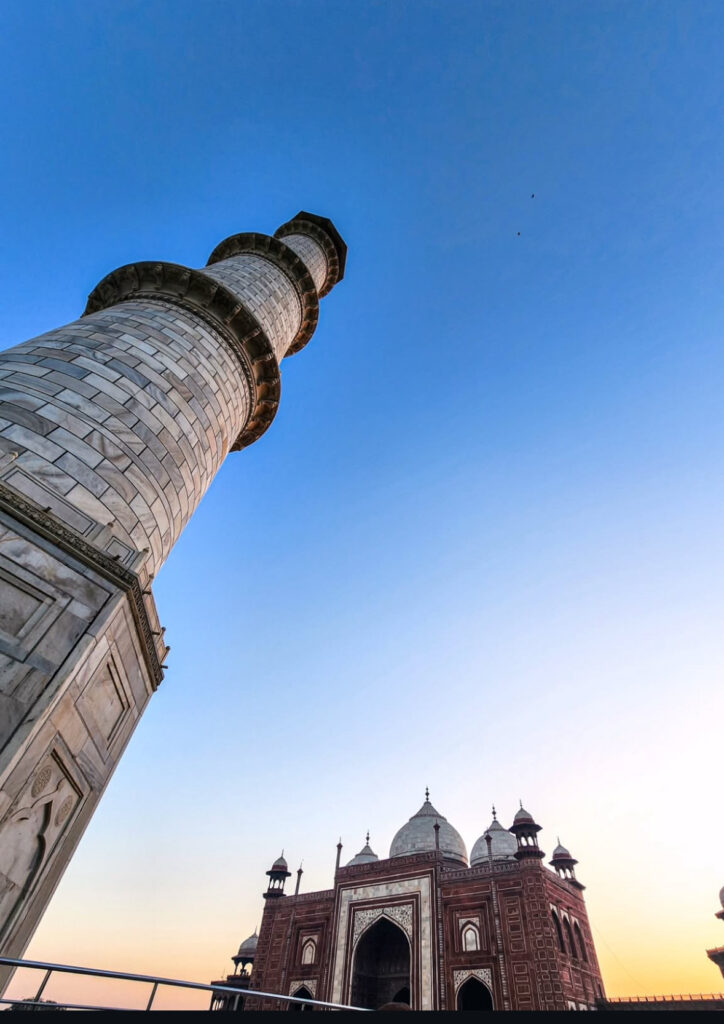
The Taj Mahal is a stunning white marble monument with symmetrical gardens and a reflection pool, symbolizing beauty and love. It was built by Mughal emperor Shah Jahan in memory of his wife, Mumtaz Mahal, who died after giving birth. Shah Jahan was inspired by deep grief to create this tomb as a reflection of paradise. Construction began in 1632 and involved over 20,000 workers, finishing around 1653. The design features both rose-red sandstone and white marble in a Persian garden style, which represents paradise. Shah Jahan also planned a black marble replica across the river, but these plans were abandoned after he was overthrown by his son.
The Taj Mahal, located on the right bank of the Yamuna River in Agra, Uttar Pradesh, is part of a 42-acre garden complex. The land was exchanged by the Kachhwaha clan of Ajmer for four mansions before the construction began. Ustad Ahmad Lahauri, a Persian-descended Indian architect, is credited as the chief designer of this iconic structure.

The Taj Mahal showcases Mughal architecture, combining Islamic, Persian, Ottoman Turkish, and Indian styles. Its layout features axial symmetry and balance, a key characteristic of Mughal design. Major elements include a grand entrance gate, a charbagh garden with a central reflecting pool, a mosque, a mirrored structure, and the main mausoleum with four minarets.
The mausoleum itself is cubic with beveled corners, giving it an octagonal plan. It is topped by an onion-shaped dome and smaller domes. Inside, the central chamber is octagonal with high walls, housing the cenotaphs of Mumtaz Mahal and Shah Jahan. The interior features beautiful inlays of semi-precious stones, Quranic inscriptions, and marble jali screens that create soft light patterns.
The Taj Mahal features four tall minarets designed to protect the main tomb and topped with lotus-shaped domes. The main entrance is a large red sandstone structure with white marble designs and intricate calligraphy. The surrounding charbagh garden, with its reflecting pool, symbolizes paradise and adds to the overall symmetry of the site.
The Taj Mahal’s design is rich in symbolism, using white marble for purity and red sandstone for stability. Its structure represents cosmic order through symmetry, while the gardens are inspired by gardens described in the Quran. The calligraphy, floral designs, and geometry convey spiritual meanings. A poetic tribute by Shah Jahan reflects on the emotional depth of the site.
Named a UNESCO World Heritage Site in 1983, the Taj Mahal is acclaimed as a significant piece of art in India, with ongoing conservation efforts managed by the Archaeological Survey of India. Environmental measures are in place to protect it from pollution. The Taj Mahal symbolizes eternal love, attracting millions of visitors annually and maintaining its presence in literature, art, and tourism. Its beauty changes with the light, enhancing its allure.
The Taj Mahal was built by Shah Jahan in memory of his beloved wife, Mumtaz Mahal. Its construction took over 20 years and involved artisans from many parts of the world, led by architect Ustad Ahmad Lahauri. The design represents Mughal architecture, showcasing perfect symmetry, intricate calligraphy, and skilled inlay work. The monument symbolizes an earthly paradise and deep devotion, capturing poetic expression.
Efforts by UNESCO and other organizations help preserve the Taj Mahal, ensuring its legacy continues. It is recognized as one of the Wonders of the World and serves as a global symbol of love and artistry.
Overall, the Taj Mahal is more than just a tomb; it is a masterpiece of love, art, and spirituality. Its beauty and the story of devotion behind it continue to inspire visitors for generations.
Feel free to ask if you want to explore any specific topics related to the Taj Mahal, such as artistic techniques, poetic verses, tourism tips, or conservation efforts.